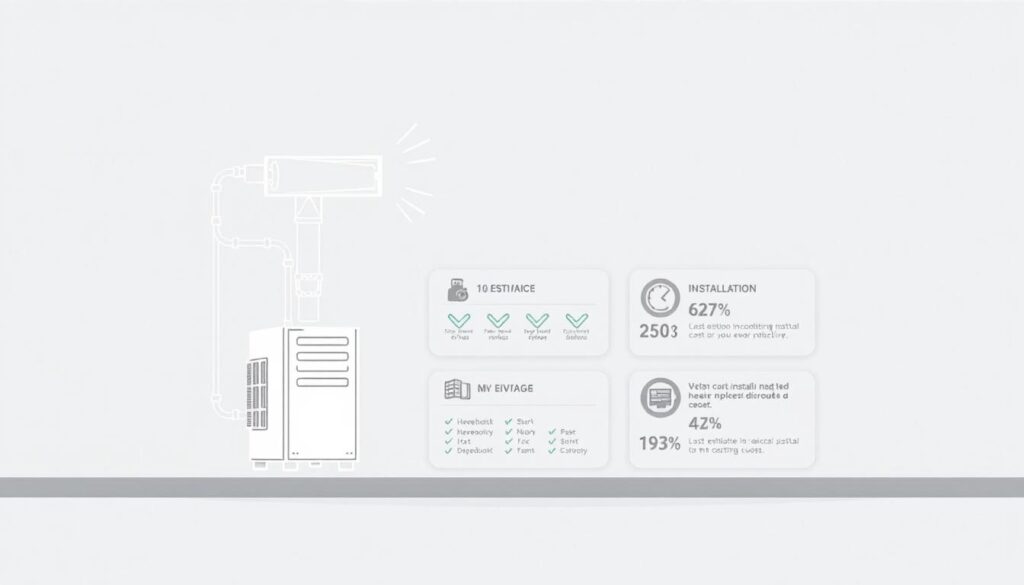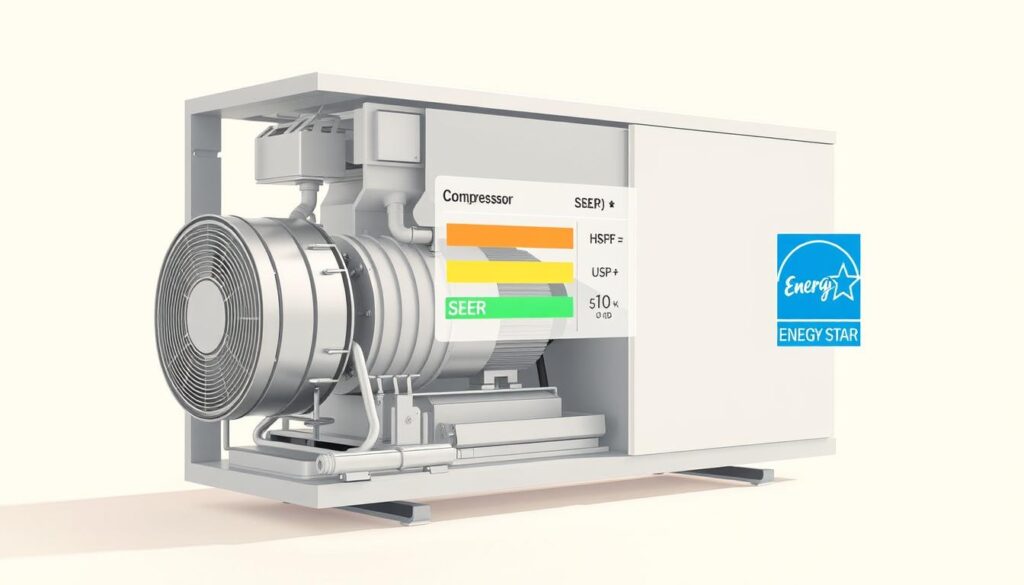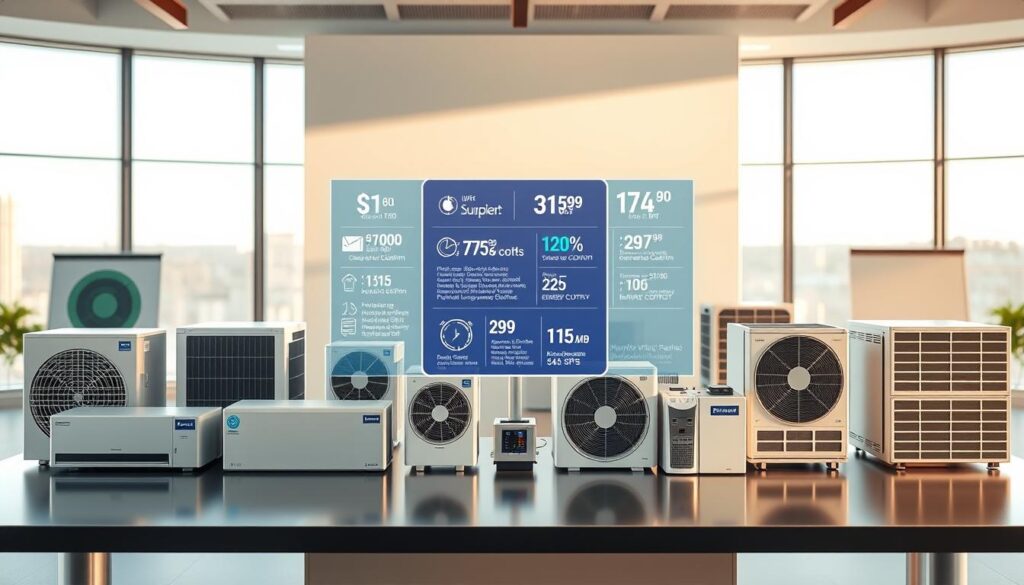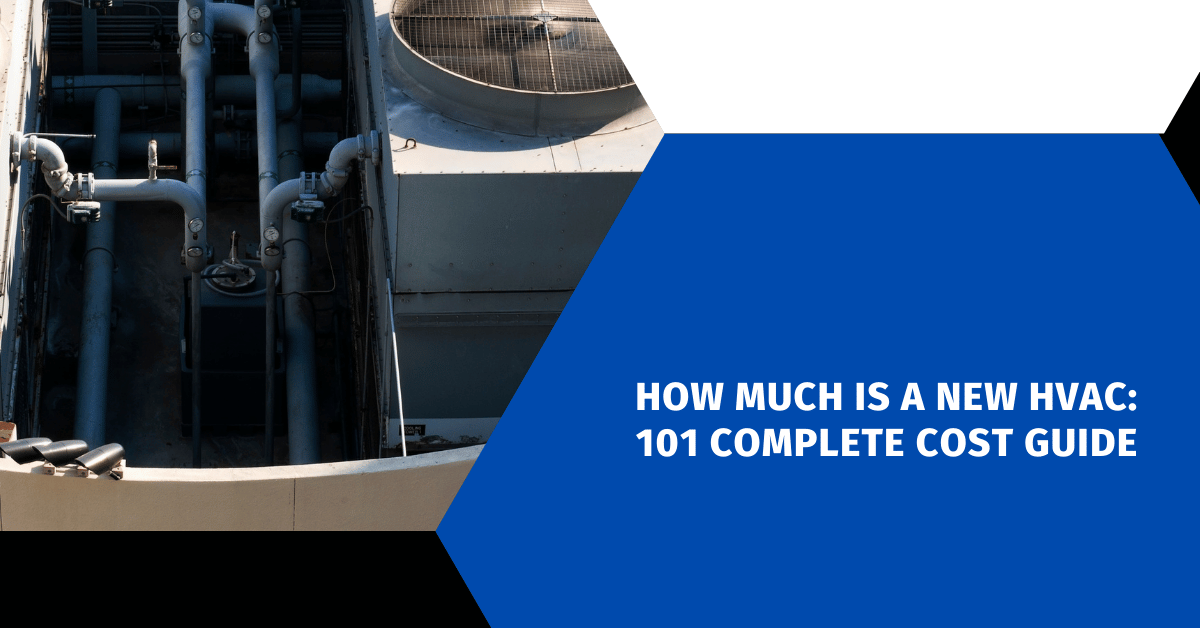Affiliate Disclosure
HVAC Guide Guys is a participant in the Amazon Services LLC Associates Program, an affiliate advertising program designed to provide a means for sites to earn advertising fees by advertising and linking to Amazon.
How Much Is a New HVAC? Are you curious about the cost of a new HVAC system? Figuring out hvac installation costs can seem like a puzzle. There are many prices and choices to consider.

Getting a new heating and cooling system is a big deal. The cost of a high-efficiency air conditioner is between $3,995 and $6,000. This includes the cost of installation by a licensed pro.
When thinking about a new HVAC, several things matter. The size of your home, the climate, and what you need from the system affect the total cost. These factors will help decide how much you’ll spend on upgrading your HVAC.
This detailed guide will cover all you need to know about HVAC prices. It aims to help you choose wisely, balancing comfort and cost.
Key Takeaways
- Average HVAC installation costs range from $3,995 to $6,000
- Prices vary based on home size and system complexity
- Professional installation ensures optimal system performance
- Energy efficiency can impact long-term cost savings
- Multiple financing options are available for HVAC replacement
Table of Contents
Understanding HVAC Systems and Their Components
When looking at HVAC prices, knowing how your home’s system works is key. HVAC systems keep your home’s temperature and air quality just right. They are complex systems designed for comfort.
The cost of your HVAC unit can change a lot. This depends on how complex it is and what parts it has. Let’s look at the main parts that make these systems efficient.
Essential Parts of an HVAC System
- Thermostat: Controls temperature and system operation
- Furnace: Generates heat for warming your home
- Condenser Unit: Releases heat outside during cooling
- Evaporator Coil: Absorbs indoor heat and humidity
- Ductwork: Distributes conditioned air throughout your home
Different Types of HVAC Systems Available
| System Type | Key Features | Best For |
|---|---|---|
| Central Air Conditioning | Whole-home cooling | Larger homes with existing ductwork |
| Ductless Mini-Split | Zone-based temperature control | Homes without ductwork or room additions |
| Heat Pump System | Heating and cooling capabilities | Moderate climate regions |
How HVAC Systems Work
HVAC systems move heat from inside to outside. In summer, air conditioners take warm air from your home. They cool it down and send it back in.
Knowing how these systems work helps you choose the right one. This way, you can pick the best HVAC for your home’s needs.
Explore Our HVAC Shop
Looking for top-rated HVAC tools, parts, and accessories? Visit our shop and find the perfect solution for your needs.
Visit the ShopHow Much Is a New HVAC: Complete Price Breakdown
Knowing the costs of a new HVAC system helps you budget for home improvements. The prices vary based on several factors that affect your total investment.
When looking at new HVAC system costs, you’ll find several key expense categories. These categories add up to the total price you’ll pay.
Labor Costs and Installation Fees
Professional installation is a big part of your HVAC investment. Labor costs usually range from $500 to $2,500. This depends on:
- How complex the installation is
- Local labor rates
- The size and type of HVAC system
- The state of your home’s ductwork
Equipment and Material Expenses
The actual HVAC system is a big part of your expenses. Prices change based on:
- The type of system (central air, heat pump, ductless)
- The brand quality
- Energy efficiency ratings
- The system’s cooling and heating capacity
Additional Costs to Consider
There are also extra costs to think about. These include:
- Ductwork modifications
- Electrical system upgrades
- Permits and inspection fees
- Removing the old HVAC equipment
Pro tip: Always get multiple quotes to ensure you’re getting competitive hvac replacement prices for your specific home needs.
Factors Affecting HVAC System Costs
Knowing what affects hvac pricing guides can help you choose wisely. The cost of an HVAC system varies based on several important factors.
Your home’s size and layout are key in determining hvac costs. Other factors that influence pricing include:
- Home Size and Layout: Larger homes need more powerful systems, which costs more
- Existing Infrastructure: The state of your current ductwork can greatly affect installation costs
- Regional Climate: Different areas need specific HVAC systems
- System Efficiency: More efficient systems cost more upfront but save on energy in the long run
Brand reputation also affects prices. Top brands charge more for their high-tech and reliable equipment. For example, a ductless air conditioner can cost between $3,000 to $6,000 after installation, depending on these factors.
When planning for your HVAC system, think about more than just the initial cost. Consider energy efficiency, maintenance needs, and long-term savings too.
Explore Our HVAC Shop
Looking for top-rated HVAC tools, parts, and accessories? Visit our shop and find the perfect solution for your needs.
Visit the ShopHVAC Energy Efficiency Ratings and Cost Savings
Understanding energy efficiency is key when picking affordable HVAC options for your home. Modern energy-efficient HVAC systems can cut your monthly bills while keeping you comfortable. Choosing the right system balances initial costs with long-term savings.

Understanding SEER Ratings
SEER (Seasonal Energy Efficiency Ratio) shows how well an air conditioning system works. It’s like miles per gallon for your car, but for cooling. Systems with higher SEER ratings use less energy.
- SEER ratings usually range from 13 to 26
- Higher ratings mean lower energy use
- Systems with ratings over 16 are very efficient
Energy Cost Calculations
Figuring out energy savings helps homeowners make better choices. A system with a higher SEER rating might cost more at first. But, it can save a lot of money over time.
| SEER Rating | Estimated Annual Savings |
|---|---|
| 13 SEER | Standard Efficiency |
| 16 SEER | Up to 13% Energy Savings |
| 20 SEER | Up to 25% Energy Savings |
Long-term Savings
Choosing energy-efficient HVAC systems can save you a lot of money in the long run. Most efficient systems pay for themselves in 5-7 years through lower energy costs.
Investing in an efficient HVAC system is not an expense, but a smart financial strategy.
When looking for affordable HVAC options, focus on systems with higher SEER ratings. Your wallet and the environment will appreciate it.
Signs It’s Time to Replace Your HVAC System
Knowing when to replace your HVAC system can save you money and avoid unexpected breakdowns. A well-working heating and cooling system keeps your home comfortable and energy-efficient. Spotting the signs that suggest it’s time for a new system is key to a smart investment.
Several critical signs point to the need for an HVAC replacement:
- Age of the system (15+ years old)
- Inconsistent or poor temperature control
- Increasing energy bills
- Frequent repair requirements
- Unusual noises or performance issues
When your system shows many warning signs, understanding hvac replacement prices is essential. Older systems often lose efficiency, causing higher energy use and costs.
| System Age | Replacement Likelihood | Potential Cost Impact |
|---|---|---|
| 0-5 years | Low | Minimal |
| 6-10 years | Moderate | Some consideration |
| 11-15 years | High | Significant |
| 15+ years | Critical | Urgent replacement recommended |
Professional HVAC technicians recommend evaluating your system’s performance annually to catch issues early and plan for replacement.
“Proactive replacement can save you from unexpected system failures and costly emergency repairs.”
When you see many signs at once, it’s time to think about getting a new HVAC system. Your home’s comfort, energy use, and long-term savings depend on making the right choice at the right time.
Explore Our HVAC Shop
Looking for top-rated HVAC tools, parts, and accessories? Visit our shop and find the perfect solution for your needs.
Visit the ShopChoosing the Right HVAC Size for Your Home
Finding the perfect size for your home’s HVAC system is key. It keeps your home comfy and helps control costs. The right size means better performance, energy use, and savings over time.
Figuring out the right HVAC size involves important factors. These factors affect both the cost and how well the system works.
Square Footage Matters
Your home’s size is a big factor in choosing the right HVAC. Here’s a simple guide:
- One ton of cooling covers 750-1000 square feet
- A 2,000-square-foot home needs a 2.0 – 2.5-ton unit
- Most homes won’t need more than a 5-ton unit
Climate Zone Considerations
The climate where you live also matters. Homes in very hot, humid areas need bigger systems. This is different from homes in milder climates.
| Climate Zone | Recommended Cooling Capacity | Typical HVAC Unit Costs |
|---|---|---|
| Hot/Humid Southern States | 3.5 – 5 tons | $5,000 – $8,500 |
| Moderate Midwest Regions | 2 – 3.5 tons | $4,000 – $6,500 |
| Cooler Northern States | 1.5 – 2.5 tons | $3,500 – $5,500 |
Home Layout Impacts Sizing
Your home’s design also affects HVAC needs. Things like ceiling height, insulation, and windows play a role. They help decide the best system size and efficiency.
Experts use special calculations to find the best HVAC size for your home. This ensures you get the right equipment for your needs.
Installation Process and Timeline
Learning about the HVAC installation process can make it easier to understand how to replace your home’s heating and cooling system. The cost of your HVAC installation can change based on the steps needed for the job.
The installation process has a clear plan to ensure your system works well and efficiently. Here are the main steps of installing your HVAC system:
- Initial Assessment and Consultation
- Experts check your home’s needs
- Talk about what you want and your budget
- System Design and Calculation
- Do a Manual J load calculation
- Find the right system size for your home
- Equipment Selection
- Pick energy-saving models
- Look at long-term pricing guides
The whole installation usually takes 1-3 days, depending on your home and the system. The pros will remove the old system, put in the new one, adjust the ducts, and test everything.
| Installation Stage | Estimated Duration | Key Activities |
|---|---|---|
| Preparation | Half Day | Site check, equipment delivery |
| System Removal | 4-6 Hours | Old system removal, site prep |
| New System Installation | 1-2 Days | Mounting new equipment, electrical work, ductwork |
| Testing and Calibration | Half Day | Check system performance, fine-tune |
After it’s all set up, you’ll get a final tour. The techs will show you how to use the system, talk about upkeep, and answer any questions about your new HVAC.
Explore Our HVAC Shop
Looking for top-rated HVAC tools, parts, and accessories? Visit our shop and find the perfect solution for your needs.
Visit the ShopHVAC Brands and Price Comparisons
Choosing the right HVAC system means knowing about different brands and their prices. Homeowners face a wide range of brands. Each offers different performance levels and prices for heating and cooling.

When looking at hvac cost estimates, some top brands stand out. Your choice depends on your budget, home size, and cooling needs.
Leading HVAC Manufacturers
- Carrier: Known for reliability and high-efficiency models
- Trane: Premium systems with advanced technology
- Lennox: Top-tier energy-efficient options
- Rheem: Budget-friendly with solid performance
- Goodman: Most affordable HVAC systems
Price Range Breakdown
HVAC system costs vary a lot based on brand and features. Here’s a general pricing overview:
- Entry-level systems: $3,000 – $5,000
- Mid-range systems: $5,000 – $8,000
- Premium systems: $8,000 – $12,000
Your specific hvac cost estimates will depend on home size, system complexity, and local installation rates. Research multiple brands to find the best balance between performance and affordability.
Financing Options and Payment Plans
Getting a new HVAC system can cost a lot for homeowners. But, there are many affordable options to help with the costs. These make upgrading your home’s comfort easier.
There are several ways to pay for your new heating and cooling system:
- Manufacturer Financing Programs
- Home Equity Loans
- Personal Loans
- HVAC-Specific Credit Cards
Many manufacturers have great financing plans. They offer low-interest rates or even zero percent for a while. Local HVAC contractors work with banks to offer flexible payment plans that fit your budget.
Government and utility rebates can also lower your costs. Check with local energy offices for these incentives:
- Federal tax credits for energy-efficient systems
- State-level renewable energy incentives
- Utility company rebate programs
Pro tip: Always compare multiple financing options and read the fine print before committing to a payment plan.
Some credit cards are made for home improvement financing. They offer extended warranties and cashback rewards for HVAC purchases. These can help manage costs and offer extra benefits.
Smart financing can turn a large upfront expense into manageable monthly payments, making home comfort upgrades more attainable.
Explore Our HVAC Shop
Looking for top-rated HVAC tools, parts, and accessories? Visit our shop and find the perfect solution for your needs.
Visit the ShopMaintenance Requirements and Ongoing Costs
Keeping your energy-efficient HVAC systems in top shape is key. Regular maintenance extends their life and saves money, as hvac pricing guides show.
There are several important tasks for routine maintenance:
- Quarterly air filter replacements
- Annual professional system inspections
- Cleaning air ducts and vents
- Checking refrigerant levels
- Lubricating moving parts
Knowing the ongoing costs is vital for those watching their budgets. Here’s a look at typical annual maintenance costs:
| Maintenance Task | Estimated Cost | Frequency |
|---|---|---|
| Professional Inspection | $80-$250 | Annually |
| Air Filter Replacement | $10-$50 | Quarterly |
| Duct Cleaning | $300-$500 | Every 3-5 Years |
Regular maintenance stops expensive repairs and keeps your HVAC running smoothly. Regular care can cut your energy bills by up to 15%.
Experts say to schedule maintenance before the hot and cold seasons to ensure the best performance.
Stick to a maintenance plan to keep your HVAC system running well. This way, you’ll save money and extend its life.
Conclusion
Figuring out the cost of a new HVAC system involves looking at several factors. Your home’s size, energy goals, and budget are all important. By getting detailed cost estimates, you can choose wisely, balancing initial costs with long-term savings.
Getting a professional’s opinion is essential when buying an HVAC system. They can guide you on sizing, suggest energy-saving options, and give you a clear price. This way, you’ll pick a system that works well and saves money.
Your HVAC system is a big investment in your home. Choosing quality, reputable brands and regular maintenance will make it last longer and work better. Planning carefully now can save you money and make your home more comfortable for years.
Even though buying an HVAC system costs a lot upfront, think of it as a long-term investment. Understanding what you need and how it will perform will save you money and improve your home’s value.

